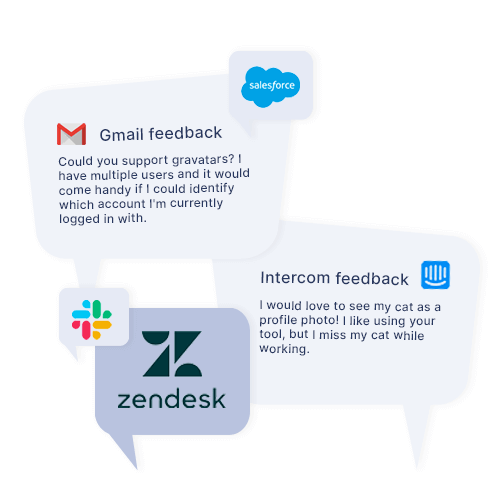In today’s world where the intersection of tech advancements and user needs makes us reinvent the way we work day by day, creative ideas have become one of the most valuable things to trade and possess.
Tech has hardly any limitations, allowing you to create anything at any scale almost instantly. But it all starts with an idea and idea generation. When you’re actively trying to come up with the next Spotify, Slack, or Trello, it may seem like all great ideas have already been used up.
Contents
Why is idea generation important?
It is the constant search for new product development opportunities. Internal ideas are generated through product team brainstorming, external ideas usually come from communication with suppliers, customers, and competitors, and idea-generation exercises.
How companies find and develop new product ideas
This is never true. Google, Apple, YouTube, and other world-changing companies haven’t gotten that far due to sheer luck but revolutionary ideas. There were other search engines, phones, and streaming services. But they lacked something important, something that won the market for the small bunch of enthusiasts. Their creative ideas hit the bull’s eye at that time and paved the way to its current success.
But how are creative ideas born? No lamp is lit above our heads, and no apple is hanging above, ready to fall. Ideas are worked out through commitment and determination. Even the sudden epiphany doesn’t appear out of the blue. It resulted from our unconsciousness and finally putting together things we were uploading to it during brainstorms, reading books, and looking around. Like any exercise of our brain, the process of idea generation can be harnessed and trained.
Let’s see what sources and new idea-generation techniques we can use to fill our brains and our product feedback ‘insights backlog’ with raw ideas.
What is idea generation in product development?
Idea generation is an intended search aimed at finding new product development opportunities. It usually means coming up with a list of ideas or multiple versions of a single idea to be examined. It consists of such steps as identifying criteria for choosing the best one, listing all the ideas, finding the most appropriate one from the list and then, developing that idea to be usable.
Top 5 sources of idea generation for product development

1. Idea-generation techniques: let your users do the dirty work
There are always issues to solve. Even the oversaturated market has a niche that hasn’t been claimed yet. Like a treasure island, it waits to be found and charted. Often the way to it is obvious, but no one pays attention.
Reviews
Look at the reviews of your or your competitors’ clients. Browse through the clients’ forums and Facebook groups. You may find a common problem that bothers them and can be a reason to give four stars out of 5 to the product. As a product manager from Self-Starters advises, search for these little “but” and “if only” words. Think about what you can do to eliminate them in your products. Just a little change in the design, a slight shift, or a seemingly insignificant feature can be a game-breaker.
Feature requests
Sometimes potential customers can unknowingly present you with the most fantastic idea of your company’s history. It may seem odd or too absurd to be made; you may even skip it as unrealistic at first. But if you suddenly feel that tingle of “what if..?”, give it a chance. Let professional designers play with this idea, and give it a new shape or purpose. The flying skateboard has become a reality already, remember?
Forums, discussions
For example, Quora reviews and Kickstarter ideas may be the infinite source of people’s creative ideas, wishes, complaints, and suggestions. Just have a look at Datacamp: the app for learning data skills. There was a high demand for learning data analytics skills without earning a degree and many people have been asking for such a solution on different platforms like Quora or Reddit. And the company launched its app for learning such skills on the go.
2. Feel the trends
Being ahead of the trends is the best possible way to do business, but you can’t create something revolutionary every season. You don’t need to. The existing trends may give you enough ideas to not only stay afloat but turn the tide and create your hypertrend or countertrend. Was there something interesting at the recent expo? Something that got way more attention than expected? Check it out and make something of a similar style, but cooler, better, and sexier! Everyone is hyping around the single top-notch thing? It will become dull, ordinary, and outdated too soon; think ahead and start preparing the opposite trend to lead it!
The trendy currents may float everywhere: on Instagram, TikTok, Reddit or on the streets. Don’t limit yourself with your professional sphere of interests: combine the uncombinable, borrow ideas from whole new sources, and you’ll become the trendsetter of your industry.
A simple and non-world-class example: COLLAR Company, a pet product manufacturer, created pet accessories with space design right before the Crew Dragon flight. The sales of space-themed collars and leashes skyrocketed just because of the clever use of out-of-industry trends.
Expand your knowledge, follow us for more!
3. Try new markets
Sometimes being a winner in your domain just isn’t enough. Expanding to new target markets may look like a significant risk of being associated with old products, but it is sometimes inevitable. The current products may get outdated, or the whole industry may decline because of the new technologies. The brightest idea here might be to change your focus and try something new. The Motorola company did it several times, and it worked perfectly.
Another reason to think about new horizons is being an absolute leader in your segment. When you have nothing to add but don’t want to get stuck until your competitors sharpen their teeth, move forward in an unexpected direction! Did you know that Red Bull has an enormous media company that brings it lots of money? For most people, the Red Bull logo is still associated with the drink only, but they have already successfully introduced themselves to the media market.
4. Ask your UI/UX designer & researcher
It’s their job to generate ideas, right? You may feel like you haven’t heard from them for a while, so just visit them and ask about the current direction. Perhaps you have some thoughts for them to play with or you have a direct problem and need something truly stunning to deal with it. Perhaps you just need a few improvements that will make your product a bestseller.
If you don’t have a researcher on your team (or want them to try something new), try the methods described by Victor Papanek in his “Design for the Real World” book. This industrial designer’s handbook offers several ways to make brand-new ideas come into your head. If you feel that you are stuck and just return to the same old set of thoughts, again and again, it may be your chance to break the vicious cycle.
5. Your product development team/product team
They are making stuff you monetize, and they know all the quirks, downsides, and features more than anyone else. Maybe your testers have something to say; maybe your developers have an idea of production optimization. Ask them for ideas, and you might learn a whole lot of facts about your product in action.
Being kind and sincere to your team and being a benevolent manager, in general, opens a great source of information for you. If your team isn’t afraid to talk to you and sometimes even to argue with you, you’ll benefit from their areas of expertise. You can’t know everything; your dev team can’t know everything. Having dozens of eyes and brains willing to check and improve is much better than having just hands doing what they are told.
Don’t forget: developing new ideas is a meticulous search for new product development opportunities. Streamline ideas coming from different sources!
Continuous Discovery: Analytics, Experiments, and AI
Shift ideation from sporadic brainstorms to an always-on discovery loop powered by product analytics, rapid experiments, and AI. Don’t wait for feedback—instrument the product so new opportunities surface daily.
Map your critical user journeys, set a north-star metric with leading indicators, and track where users hesitate or drop off. Combine event analytics with session replays and heatmaps, then correlate patterns with support tickets and NPS verbatims to spot unmet needs and friction.
- Validate demand with painted-door tests and waitlist CTAs before you build.
- Ship micro-experiments behind feature flags; A/B test onboarding, copy, and pricing.
- Use AI to cluster feedback and usage anomalies into themes, auto-tagging ideas in your insights backlog.
- Summarize interviews with LLMs and generate “How might we” prompts or Jobs-to-be-Done statements to spark concepts.
Close the loop by reviewing signals weekly with design, product, and engineering. Turn top opportunities into hypotheses and story maps, run the next experiment, and log outcomes. Over time, this flywheel becomes your most reliable source of breakthrough ideas.
Handpicked ideas
Wrap-up
The flow of new ideas is the bloodstream of any business. Even the best product may (and eventually will) be overthrown by the competitors or forgotten by clients. You need to search for new solutions every day, and you don’t have to be alone here. Hopefully, these extra five sources added to your creativity will lead you to something the whole world will benefit from.
Product Idea Generation: FAQs for Product Teams
What is idea generation in product development?
It’s the intentional search for new product opportunities. Teams capture many ideas, set selection criteria, choose the strongest, and shape them into testable concepts.
Where should we look for ideas first?
Start with customers—reviews, feature requests, forums, and community groups. Then layer in competitor insights, internal brainstorms, and stakeholder interviews to widen the net.
How do we convert user feedback into an actionable backlog?
Create a single insights backlog that aggregates every channel. Tag and cluster themes, link them to personas and journeys, and size impact versus effort before you prioritize.
How can we quickly validate trend‑based concepts?
Run lightweight checks—social listening, quick prototypes, smoke tests or simple landing pages. Nail the user problem first so you’re not chasing hype, and set crisp success criteria to read early signal.
When is it smart to explore a new market?
Explore new markets when growth plateaus, the category commoditizes, or tech shifts threaten your core. Test with small pilots, partnerships, or limited launches to gauge fit without diluting the brand.
How should we engage UI/UX researchers in ideation?
Run discovery sprints to frame problems, generate options, and test assumptions. Mix field studies with usability tests, and bring in unconventional techniques to break ruts.
How can dev and QA contribute high‑quality ideas?
Create regular ideation rituals, a safe channel for suggestions, and recognize wins. Encourage experiments that lift quality, performance, or workflow—the pain points they see every day.
What criteria should we use to prioritize ideas?
Balance customer value, strategic fit, feasibility, risk, and differentiation. Use a scoring model (e.g., RICE) and revisit it quarterly as new data and market shifts roll in.
What helps manage an insights backlog at scale?
Use a centralized repository with tagging, de‑duplication, and traceability from insight to idea to roadmap. Share regular updates with stakeholders to keep alignment and momentum.
About the author: Nancy Kelly is a content creator at self-starters.com, the project about gaining tech skills online. She is interested in UX design and technology and always watches trends in these fields. Moreover, she loves to write, all the process from the research to publishing a new blog post.
